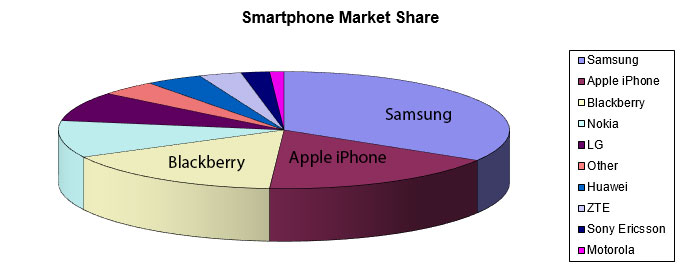Market Share
Market Share is like a pie, and most businesses want as big of a piece of it as they can get!
Market Share is measured in either volume (units) or revenue (cash). For example, an industry may be worth $1bn dollars annually.
Market Share = (total company sales / total industry sales) x 100 [ this is the Market Share formula]
To illustrate the concept of Market Share, we will use an example that you will be able relate to – mobile phones market share. However, we will specifically look at smartphone market share in units (a smartphone is a mobile that can perform many of the functions that a computer can, such as sending e-mails and browsing the internet. Examples of smartphones are the Apple iphone, Samsung Galaxy SII, HTC, Nokia Lumia, etc)
The example is for illustrative purposes; hence the numbers are made up to make understanding it easier. However, Samsung’s and Apple’s dominance is very much true in real life!
The chart and table below show the Market Share of different smartphone manufacturers over a year (in units).
Let’s assume that 1 billion (that’s 1,000 million) smartphone handsets were sold in 2013.
According the chart, Samsung had a 33% share of the market. That means that Samsung would have sold a third of a billion or 330 million units (See table below)
|
Smartphone (Mobile) |
Market Share |
Units Sold |
|
Samsung |
33% |
330,000,000 |
|
Apple iPhone |
17% |
170,000,000 |
|
Blackberry |
16% |
160,000,000 |
|
Nokia |
10% |
100,000,000 |
|
LG |
8% |
80,000,000 |
|
Other |
4% |
40,000,000 |
|
Huawei |
4% |
40,000,000 |
|
ZTE |
3% |
30,000,000 |
|
Sony Ericsson |
2% |
20,000,000 |
|
Motorola |
1% |
10,000,000 |
Another market share concept – the outpacing of rivals.
Most companies aim to increase their sales year on year, and many do.
Let’s assume that the market ( the total volume of smartphone sales in this case) grew to 1.5bn the following year (ie a 50% increase on the previous year), but Samsung’s smartphone sales volume grew by 100% (from 330m units to 660m units), then Samsung would be growing faster than the Market, because it’s growth would be 100%, while the market as a whole only grew by 50%. Samsung would aim to maintain this outpacing of its rivals. Its sales may have increased significantly because of the release of a new function unique to it’s latest phone.
The outpacing of rivals often happens in real life. During the 2007-2009 recession, Discounter stores such as Aldi and Lidl (budget German supermarkets stores) took advantage of the reduced disposable income that people had as they lost jobs because of the collapse of Lehman Brothers (the Investment Bank) as well as many other private companies and government departments, which made a lot of “austerity” cuts, as they had to reduce spending in order to bring the economy back into line.
